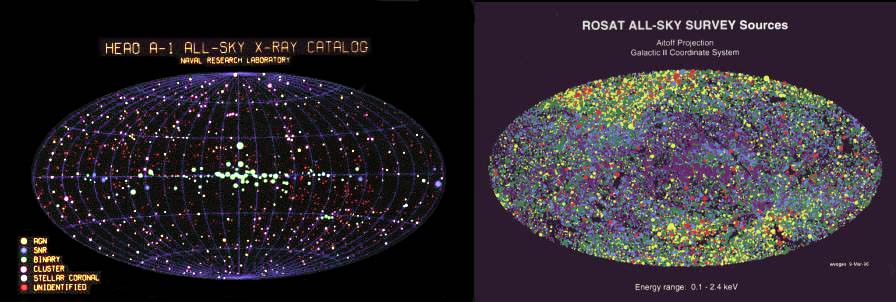
 Credit:left: Naval Research Lab; right: Max-Planck-Institut für extraterrestrische Physik and the ROSAT Mission
Credit:left: Naval Research Lab; right: Max-Planck-Institut für extraterrestrische Physik and the ROSAT Mission
The Growth of Sensitivity
The development of all branches of astronomy proceeds by examining large
sections of the sky and categorizing the bright sources which may be found.
In the early days of X-ray astronomy, observatories were designed to survey
large regions of the sky with rather poor spatial resolving power, and
rather low sensitivity. These surveys could observe only the brightest
sources, yet they managed to uncover most of the important classes of X-ray
emitting objects. One of the earliest and most important of these early
sky surveys was undertaken by the A1 instrument on the first High Energy Astrophysical
Observatory (HEAO-1). The A1 sky map (in the energy range 0.2-25 keV)
is shown at the above left; there's about 1000 sources pictured covering
almost all important astrophysical types of objects. In 1990, about 13
years after the launch of HEAO-1, another X-ray all sky survey was
undertaken by the ROSAT satellite.
ROSAT had a narrow energy range (0.2-2.4 keV) but much higher spatial and
flux sensitivity. The all sky map obtained by ROSAT is shown above right.
This map (from the second processing of the 6 months of all-sky survey data
obtained by ROSAT) contains more than 77,000 sources; the source color
represents a measure of the source spectrum.
Last Week *
HEA Dictionary * Archive
* Search HEAPOW
* Education
Each week the HEASARC
brings you new, exciting and beautiful images from X-ray and Gamma ray
astronomy. Check back each week and be sure to check out the HEAPOW archive!
Page Author: Dr. Michael F.
Corcoran
Last modified May 26, 2001


